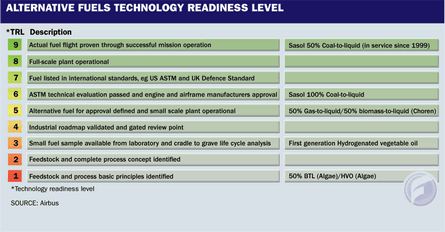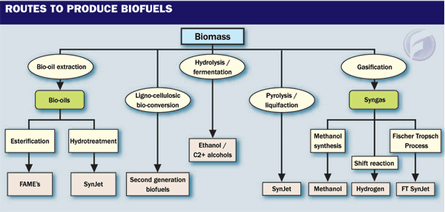Richard Altman felt sufficiently inspired to draw a succinct analogy at the recent Future Fuels summit in London to help illustrate aviation's dilemma in its search for fuel alternatives.
Speaking to delegates, many from the USA-based Commercial Aviation Alternative Fuels Initiative (CAAFI), which pools the resources of major sponsors and stakeholders from across aviation in an effort to advance and accelerate the development of alternatives, he asked them to imagine the global airline industry as a family unit.
"Your family economics are, at the very least, tenuous. You just had to take draconian measures to keep the family together. Consequently you drastically cut family spending. Even with these measures the family budget has gone up. Over a third of what is left is committed to fuel expenses.
"Even so, you have no idea of what the price of that fuel will be when buying it that day. Volatility has more than tripled, on the basis of the fuel market and local weather, sometimes forcing you to tanker fuel from far-off destinations so that you can go to work.
 |
|---|
© Jemma Robinson |
Emissions Cut
"You have no option other than liquid fuels. The solar panels and windmills that your neighbours use are not available to you to meet the majority of your family needs. What's even worse is that your neighbours complain to the town officials that you are the worst polluter in the neighbourhood."
CAAFI executive director Altman wonders exactly how could this have happened since aviation's total contribution to emissions is less than 3% and over the past 40 years modern aircraft have seen emissions reductions of the order of 60%.
"The most recent vehicle you purchased achieves nearly 80 miles to the gallon per passenger at cruise - three times more efficient than the average car with little more than one passenger being carried per trip," says Altman.
Worse, while you account for only 8% of the fuel industry's transport market base, you are a difficult customer, needing a complicated specification - low freeze points and high flash points. No wonder that it takes over 10 years to certificate a new fuel for aviation.
"What rational investor in an energy product would wait 10 years to see whether a project that they are considering to serve your family will be viable?" Altman asks.
That is precisely why CAAFI was formed, first uniting US manufacturers, airports and regulators before broadening membership to gather problem solvers from over a dozen universities, four continents, government agencies and advocates from nearly 20 energy suppliers (most of them biofuel companies).
CAAFI panels examine production and delivery, certification and qualification, economic, business and environmental issues and research and development before preparing internal "roadmaps" that guide its certification panel. This prepares fuel processes for standards-setting body ASTM International to consider.
 |
|---|
"Together we realise that we have strengths that allow us to be masters of our future rather than victims of fate. We can be 'first movers' to implement alternative fuels that simultaneously improve the environmental footprint of our airline family members and allow them to be economically viable," says Altman.
Warsaw Meeting
ASTM Subcommittee D02.J on Aviation Fuels met earlier this month in Warsaw, Poland to discuss updates on recent proposals for aviation fuels, ranging from Fischer-Tropsch methods and biomass conversion methods, to reviewing and updating the fully synthetic fuel at Johannesburg International airport produced by South African oil company Sasol.
On the agenda was CAAFI's work on a proposed protocol to streamline the approvals procedure within ASTM, which is intended to assess the composition of a proposed fuel and any contamination risks from its manufacture.
Should the product be compositionally similar to fuels that have already undergone extensive testing (such as Fischer-Tropsch products), then any similarities could be taken into account, streamlining the approval process, reducing the time and cost of approval.
For fuels that differ compositionally from historic experience, a stage-gated approach is proposed - the more novel the fuel, the more extensive is the testing.
Essentially, this could provide support for alternative fuel producers that would otherwise have to commit heavy capital investment in the processing plant simply to produce the large volumes of alternative fuels necessary to meet the testing needs - albeit with no guarantee of approval.
"This is seen as stifling the alternative fuels market as investors are asked to take on significant financial risk with no guarantee of when, or even if, approval might be granted. The new approval protocol is intended to address this and aid in bringing a new fuel to market, stimulate investment and yet still ensure that sa fety remains the primary concern," says Shell's Rob Midgley.
Engine manufacturers will confirm they need a lot of fuel for testing. Rolls-Royce's fluids specialist Chris Lewis, speaking of R-R's biofuels initiative with Air New Zealand, says the engine-maker looked at several candidate fuels that fitted the key criteria of being technically viable and sustainable, and scaleable in industrial terms.
"We are interested in talking to anyone active in this area. Several specimens of hydrogenated vegetable oils have been offered, but at the end of the day we need good quality and quality in sufficient quantities," Lewis says.
Research to Certification
A specific area CAAFI wants to strengthen is not only how it transitions from research programmes such as the US Defense Advanced Research Project Agency's hydrogenated vegetable oil and forthcoming algae projects to certification in the most expeditious manner, but also how to secure sufficient fuel quantities - 950,000 litres (250,000USgal) to 1.9 million litres in a timely manner to meet its 2013 goal of biofuels approvals for jets.
Another major tactical issue is to find a way for biofuel companies to provide data to the certification authorities and still protect their intellectual property.
In an effort to demonstrate leadership, Shell aviation technology manager Paul Bogers explains why a report on Airbus's signal A380 demonstration flight in February powered with a gas-to-liquid kerosene blend was to be presented to ASTM and its UK equivalent, the UK Aviation Fuels Committee. "The industry is only going to move forward if we share this data," says Bogers.
Sébastien Rémy, head of Airbus's alternative fuels research programme, agrees: "Everyone will end up using the same fuel so sharing the knowledge simply makes better use of the resources available and avoids duplication."
While CAAFI hopes its simplified procedure will be formally adopted as an ASTM protocol by year-end, there will be still real concern about how alternatives can be produced to a consistent standard to meet the certificated standard.
From the engine manufacturer's point of view, R-R's Lewis insists that certification is often a beginning of a process as production consistency represents a key safety criteria. Seal swell, lubricity and higher maintenance issues aside, all of which could influence possible deployment, certification is not the end game. "There have been many incidents when specifications have caused great problems because they assume a known set of characteristics. The buck stops with the engine manufacturer and we can't say, as much as we would like to, yes it meets the spec, go ahead and use it."
50/50 Mix Goal
Tim Edwards, a senior scientist at the US Air Force Research Laboratory's fuels branch, also makes this point. While the USAF's near-term goal is to use a 50/50 Fischer-Tropsch/JP-8 blend certificated throughout its fleet by early 2016, ensuring the consistency of jet fuels between manufacturers, processes and feedstocks remains a key issue.
"How to ensure a consistent product in specification? What are the limits of the fuel composition?" asks Edwards.
With an ongoing Defense Energy Support Center Request for Information for a 760 million litre purchase, it would seem wise for fuel producers to pay attention to ensuring the robustness of the processing capability as well as coming up with an eureka proposition.
While safety remains at the heart of any alternative proposal, sustainability ranks equally.
Altman says that before the ongoing Partner study to analyse environmental lifecycle gains "well to wake" is complete, even experts should be wary of making swift judgements, as studies have shown that coal-to-liquid fuels with carbon capture and sequestration technology can reduce the carbon footprint of biodiesel by 25% depending on feedstock. Local air quality gains on species such as small particles - a significant carcinogen - could also figure in the benefits cited by some alternative fuels.
"Sustainability has to be at the core of what we want to do," says Lewis.
 |
|---|
Related content
Power players - alternative fuels directory
Alternative fuels pioneers urged to share information
Source: Flight International























